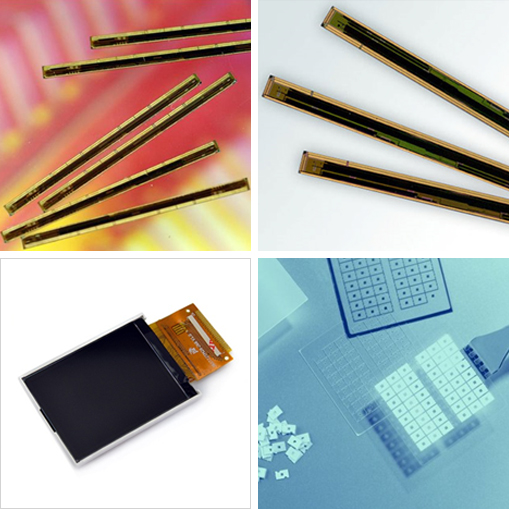Industries We Serve
As one of the largest back-end toll processing company in Korea.
DDIC

A display driver is an integrated circuit(IC) that acts as an interface between a microprocessor and
an LCD to regulate the display system in mobile phones, desktops, and other electronic devices.
The driver IC in electronic devices receive image data and deliver a current to activate the liquid crystal-containing pixels on the screen.
Once the liquid crystals are charged, they bend and change the intensity of light.
THen they combine with the color filters on the glass substrate to produce a sharp image on the display panel.
Display driver ICs form a significant component of display devices.

Outlook of the DDIC market
The global DDIC market is envisaged to grow impressively and will post a CAGR of more than 19% over the next 5 years.
With a growing preference for better image resolution, the DDIC market is expected to have a positive outlook in the future.
Due to the recent advances in technology in the television industry, the consumer preferences have also changed significantly.
The television market has evolved considerably from CRTs to LCDs, LEDs, and is now moving towards organic LED(OLED) TVs.
As consumers prefer watching better quality picture, the resolution format of televisions has also been constantly evolving.
Since the primary function of TV DDICs is to provide better image quality,
the changing consumer preference for crisp and sharp pictures resolution will propel the growth prospects of this market in the coming years.
One of the significant trends spurring the growth prospects of this market is the emergence of the Internet of Things(IoT),
which helps connect electronic devices to the Internet, thereby facilitating data transfer over a wireless network.
However, for an electronic device to be compatible with this technology, it is essential for the device to have sensors and actuators that play a vital role in mobile sensing.
For example, Samsung Electronics recently announced that its 2016 lineup of smart TVs are IoT-ready,
indicating that these TVs will be compatible with Samsung's IoT platform known as SmartThings.
These televisions can control SmartThing sensors along with other SmartThings-compatible devices, including connected lights, cameras, and thermostats.
The extensive applications of IoT in developing smart televisions, smart wearables, smart homes, industrial automation,
and automated cars will impel the growth prospects of this market over the forecast period.

Geographical segmentation
and analysis of the DDIC market for TVs
In terms of geography, the APAC region dominated the global DDIC market for TVs and is expected to reach more than USD 2 billion by 2020.
APAC is the hub for manufacturers of flat panel televisions such as Samsung, Sharp, Sony,
Panasonic, Micromax, Haier, and LG, most of which are established in South Korea, China, and Japan. Moreover, India and China, two of the world's fastest growing economies, are located in the APAC region and with China emerging as a leading hub for TV display manufacturers, this market is anticipated to have a promising future over the next five years.
Competitive landscape and key vendors
The global DDIC market for TVs is experiencing significant demand and supply chain shifts.
Most providers in the APAC region are involved in substantial ramp-ups and stiff competition. Moreover, the increasing competition from Taiwan and Korea-based semiconductor component manufacturers will lead to providers suffering losses during the next five years. Also, the growing competition in the semiconductor market is a challenge for long-time market leaders like Samsung. The market vendors are trying to gain more market shares by launching advanced DDICs in the market, especially for new 4K2K TVs.
The vendors in the market compete on the basis of factors such as innovative technological features, price, reputation, distribution, and brand presence in the global market.





